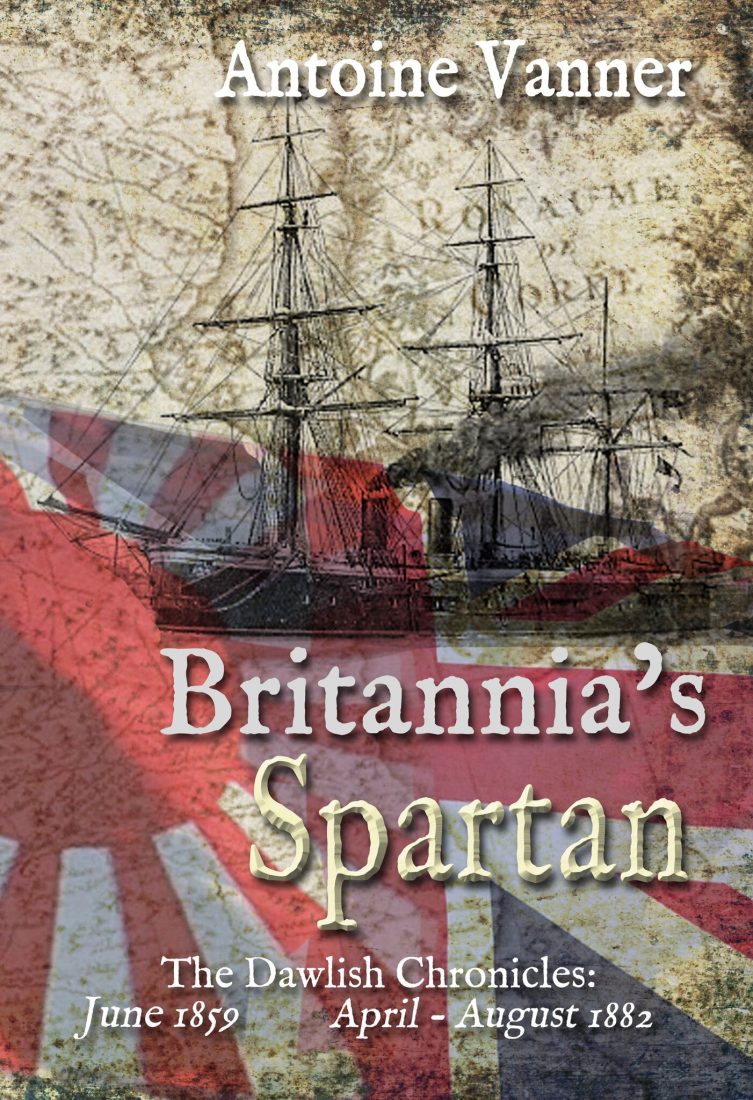The Royal Navy’s End of Fighting Sail –
Sidon, Beirut and Acre, 1840
Though steam propulsion was first applied to warships, on a small scale, in the late 1830s, it was to take over half a century more before sail was finally abandoned by the world’s navies. The process was paralleled with the replacement of wood by metal – initially iron and later steel – for construction. 1840 was however to see the last major action by the Royal Navy in which a sailing wooden line-of-battle ship, of a type almost identical to those which fought under Nelson at Trafalgar in 1805, was to play the leading role. It was however supported by small steamers. The scene was to be Sidon the coast of Lebanon, then regarded as part of the Ottoman – and temporarily Egyptian – province of Syria, in 1840.
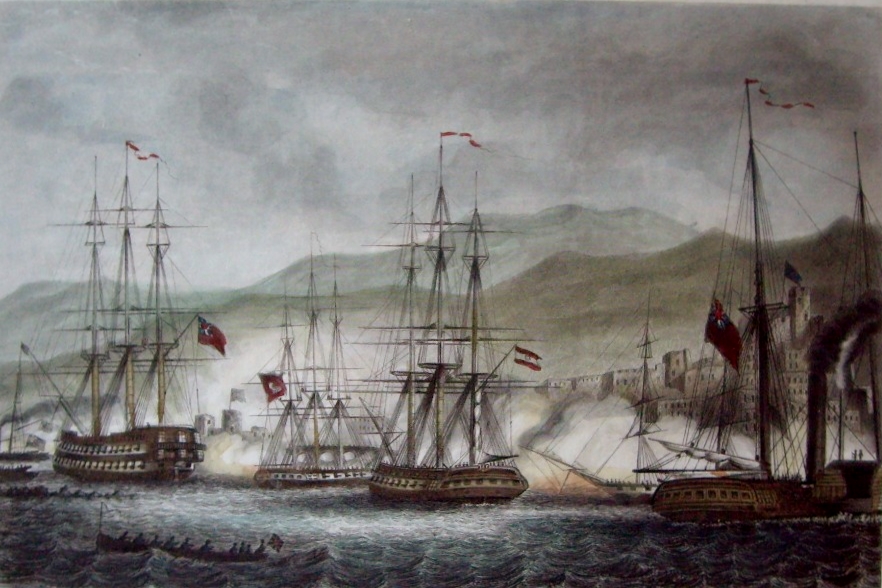
Bombardment of Sidon, September 27th 1840
Present conflicts in the Middle East are only the latest in a long series of struggles for power which go back to the dawn of history. In the last two centuries however these clashes have arisen from the weakening and eventual demise of the Ottoman Empire – a development which still has massive influence on events today.
In the early nineteenth century the Ottoman Sultan in Istanbul ruled, in theory at least, a vast empire that stretched from Libya in the west to the Arabian Gulf in the east, and from what is now Romania and Serbia in the north to the Sudan in the south. A weak central government, all too often bedevilled by corruption and by difficulties in communication over such a vast area, made it easy for local governors to set themselves up as semi-independent rulers.
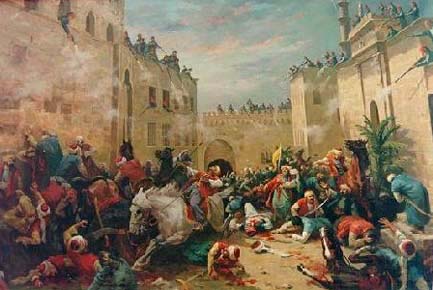
The massacre of the Mamluks in the citadel of Cairo, March 1811
The most notable of these ambitious local governors was Muhammad Ali (1769 – 1849), an Albanian general in the Ottoman Army who was appointed governor of Egypt in 1805. His first step in consolidating his power was to eliminate the Mamluks, the warrior caste which had ruled Egypt, under the Sultan, for over 600 years. He did so in 1811 by inviting the Mamluk leaders to a celebration at the Cairo Citadel. Once gathered there, they were surrounded by Muhammad Ali’s troops and slaughtered. He was now de-facto ruler of Egypt and the Sudan. By the 1820s he was arguably as powerful as the Sultan himself.


Muhammad Ali
Muhammad Ali’s only setback in this period stemmed from Intervention in the Greek War of Liberation, which began in 1821. The Sultan’s army proved incapable of putting down the revolt and Muhammad Ali was offered the island of Crete in exchange for his support. Over 16,000 Egyptian soldiers, supported by the modern fleet that was being built up in Egypt, went to Greece under the command of Muhammad Ali’s son, Ibrahim Pasha. This led to intervention on behalf of the Greeks by Britain, France and Russia, culminating in the battle of Navarino in 1827 in which the entire Egyptian navy was sunk by an allied fleet, under the command of Admiral Edward Codrington (1770–1851). This was the last major fleet action under sail and, most appropriately, Codrington had been one of Nelson’s “Band of Brothers”. He had joined the Royal Navy in 1783 and had been present at the battles of the Glorious First of June (1796) and Trafalgar (1805), commanding HMS Orion at the latter.
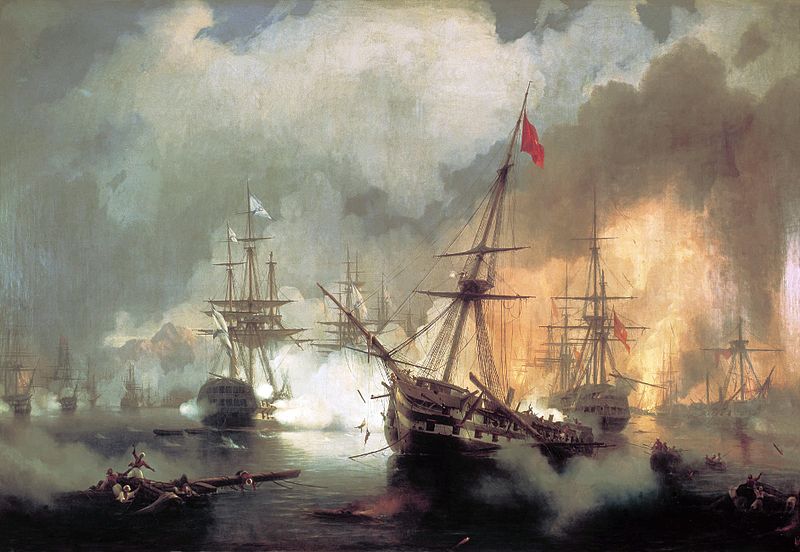
The destruction of the Egyptian fleet at Navarino, October 1827
In compensation for the loss of his fleet, Muhammad Ali asked the Sultan for Syria – a term which then included modern Lebanon and Israel in addition to the country now known as Syria. The Sultan refused and in the early 1830s Muhammad Ali, successfully seized Syria, and much of Arabia, in a campaign that was notable for Ottoman ineptitude.
A mixture of medieval despot and enthusiast for modernisation, Muhammad Ali now concentrated on building Egypt into a powerful and independent European-style state. No opposition was allowed and the process was often brutal. He set out to streamline the economy, train a professional bureaucracy, and build a modern military machine. He not only encouraged agriculture – the global demand for cotton was insatiable – and he built an industrial base, primarily focused on weapons production. By the end of the 1830s, Egypt’s war industries had constructed nine 100-gun warships and were turning out 1,600 muskets a month.
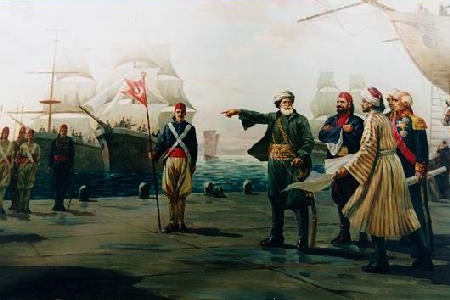
Muhammed Ali demanding construction of modern warships
In 1839, the Ottoman Empire, now ruled by the young Sultan Abdülmecid, attempted to retake Syria. Ottoman ground forces were once again routed. In June 1840, the entire Ottoman navy defected to Muhammed Ali. The French Government, with aspirations to regain control of the area which Napoleon had won briefly, then lost, decided to offer full support to Muhammad Ali. This would involve a major strategic reorientation in the Middle East and indeed held the seeds of a general European conflict (WW1 seven decades too soon!). Britain, Austria, Prussia and Russia decided that preservation of the Ottoman Empire was paramount and decided to intervene jointly to prevent total collapse.
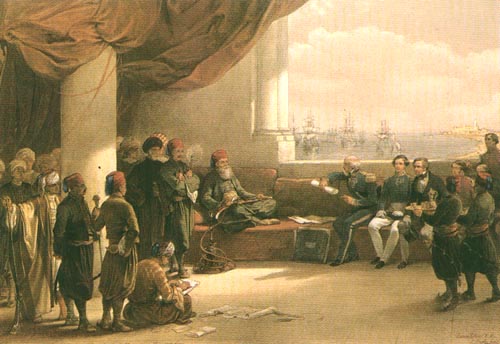
Western negotiations with Muhammed Ali 1839
By the “Convention of London”, signed in July 1840, these powers offered Muhammad Ali and his heirs permanent control over Egypt, the Sudan and the “Eyalet of Acre” (an area roughly corresponding to modern Israel, Palestine and Southern Lebanon) as nominal territories of the Ottoman Empire. Muhammad Ali hesitated, believing that he could rely on French support. This was a fatal miscalculation.
British and Austrian naval forces moved into action in September 1840. Faced with the possibility that confrontation with Britain could mean war, France, pragmatically but ingloriously, changed sides the following month, aligning itself with the other European nations against Muhammad Ali. By this time the Royal Navy and the Austrian Navy had already been in action. Alexandria, to where the defecting Ottoman fleet had withdrawn, was blockaded and forces were concentrated on Sidon and Beirut on the Lebanese coast. HMS Gorgon
HMS Gorgon
At Sidon the withdrawal of the Egyptian garrison was demanded by the British commander, Commodore Charles Napier (1786-1860). A refusal bought bombardment by Napier’s squadron on September 27th. This force was led by the HMS Thunderer, a two-deck 84-gun second rate ship of the line, launched in 1831 but not significantly different to ships of the Napoleonic era. In support was a relic of that period, the 18-gun brig-sloop HMS Wasp, launched in 1812. Significantly however these two sailing vessels were supported by four steam vessels, Cyclops, Gorgon, Stromboli and Hydra. Further support was provided by the Austrian sailing frigate Guerrierea of 48-guns and the Ottoman corvette Gulsefide.
The contemporary illustration below – by A Lieutenant J.F.Warre RN (of whom I have no further details) – shows the Thunderer at the centre and the Ottoman and Austrian vessels to the right. The paddle steamers to the left could be any of the four such British vessels present.
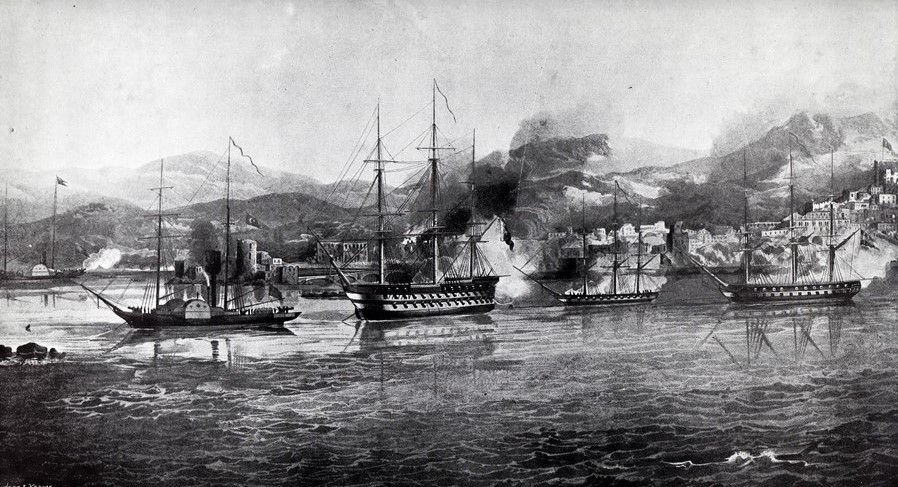
Bombardment of Sidon, September 27th 1840
The bombardment seems to have driven the Egyptian defenders from their positions and, in the best Royal Navy tradition, a naval brigade landed under Napier’s personal command suppressed any remaining opposition and captured many prisoners. Beirut was subjected to similar treatment but did not yield until October 9th, after Napier had again landed and had conducted a vigorous and successful land campaign.
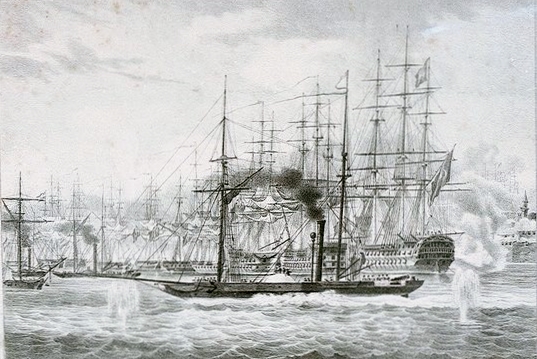
 Paddle sloop HMS Phoenix in action at Acre
Paddle sloop HMS Phoenix in action at Acre
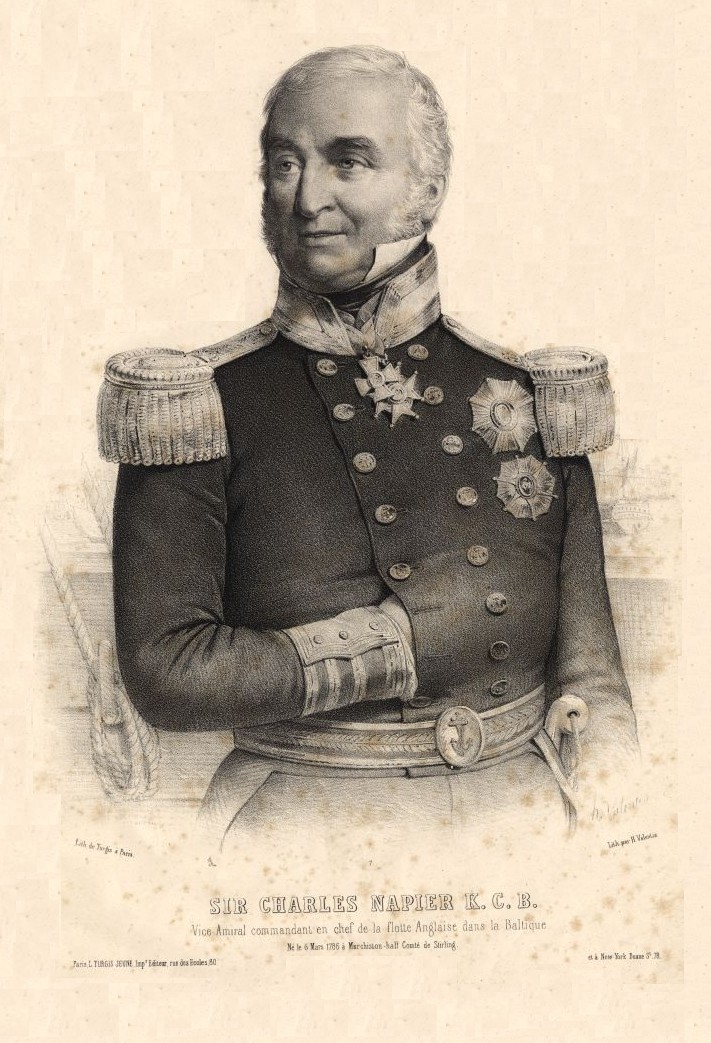
Sir Charles Napier
Acre (just north of Haifa) was the remaining Egyptian stronghold on the Eastern Mediterranean coast. British and Austrian forces, attacked again, led by HMS Thunderer. Following a bombardment on November 3rd 1840 a small landing party of Austrian, British and Ottoman troops, led personally by the Austrian fleet commander, Archduke Friedrich, took the citadel after the Egyptian garrison had fled.
Muhammad Ali now accepted the inevitable and assented to the terms of the Convention of London on November 27th. He renounced his claims over Crete and Western Arabia and agreed to hand back the Ottoman fleet and to downsize his remaining naval forces and standing army. In return, he and his descendants would enjoy hereditary rule over Egypt and the Sudan. The dynasty he established was to rule Egypt – not always gloriously or successfully – until its final representative, King Farouk, was ousted in the 1952 Revolution.
HMS Thunderer was to serve on towards the dawn of a new age of naval technology and 1863 was fitted with iron plates for trials of new armour-piercing guns. She survived as a storage hulk until 1901, initially renamed Comet, and subsequently Nettle, one of the last links with the Age of Fighting Sail.
Do you enjoy naval fiction?
You may enjoy Britannia’s Spartan
It’s 1882 and Captain Nicholas Dawlish RN has just taken command of the Royal Navy’s newest cruiser, HMS Leonidas. Her voyage to the Far East is to be a peaceful venture, a test of this innovative vessel’s engines and boilers.
But Dawlish has no forewarning of the nightmare of riot, treachery, massacre and battle he and his crew will encounter.
A new balance of power is emerging in the Far East. Imperial China, weak and corrupt, is challenged by a rapidly modernising Japan, while Russia threatens from the north. They all need to control Korea, a kingdom frozen in time and reluctant to emerge from centuries of isolation.
Dawlish finds himself a critical player in a complex political powder keg. He must take account of a weak Korean king and his shrewd queen, of murderous palace intrigue, of a powerbroker who seems more American than Chinese and a Japanese naval captain whom he will come to despise and admire in equal measure. With each step he must risk repudiation by his own superiors. And he will have no one to turn to for guidance . . .
Britannia’s Spartan sees Dawlish drawn into fierce battles on sea and land. Daring and initiative have already brought him rapid advancement and he hungers for more. But is he at last out of his depth?
Below are the nine Dawlish Chronicles novels published to date, shown in chronological order. All can be read as “stand-alones”. Click on the banner for more information or on the “BOOKS” tab above. All are available in Paperback or Kindle format and can read at no extra charge by Kindle Unlimited or Kindle Prime Subscribers.
Six free short-stories are available for download to your Kindle. Access them by registering for the Dawlish Chronicles mailing list – just click on the banner below. You’ll be kept updated on new books and will receive other free stories at intervals.


